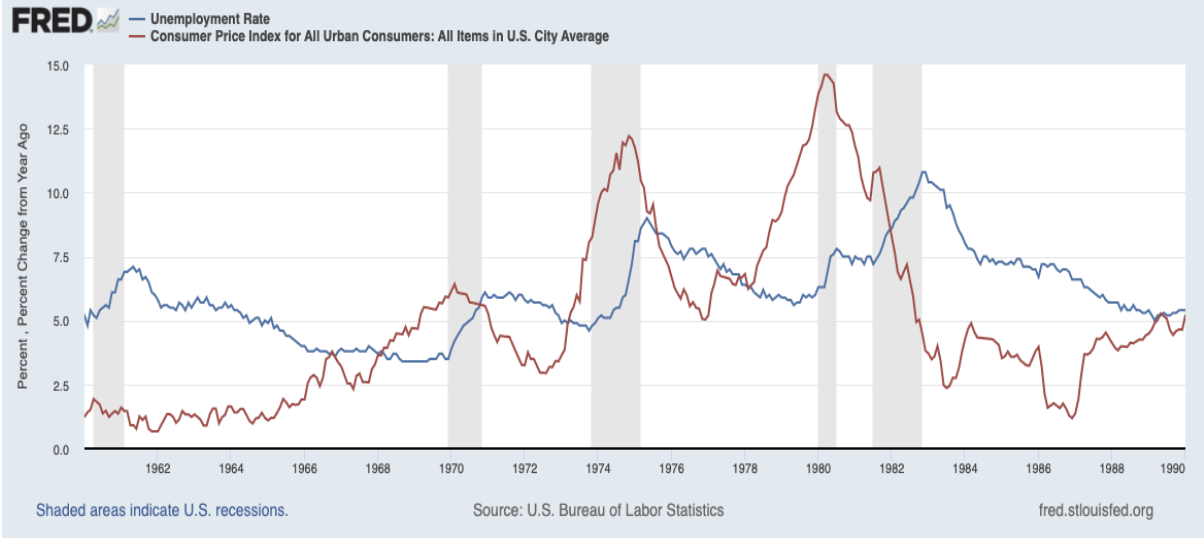Stagflation is when high inflation coincides with a weak economy. Typically, inflation accompanies strong economic growth, while slowdowns lead to falling prices and rising unemployment.
What is stagflation?
The term "stagflation" emerged during the 1970s oil crisis. In response to U.S. support for Israel, OPEC's 1973 oil embargo triggered soaring energy and gas prices.1 Further economic strain came in the 1980s, influenced by the Iranian Revolution, rising unemployment, and easy monetary policy.
By 1980, the consumer price index had surged 13.5%, prompting the Federal Reserve to raise interest rates to 20%—the highest level in history.2

Wise takeaway on stagflation
- Stagflation occurs when inflation is high but economic growth is flat.
- The last time the U.S. experienced stagflation was during the 1970s oil crisis.
- Economists and analysts are worried stagflation it could occur in the next year.
- Investors can hedge against stagflation with commodities, dividend stocks, or a barbell strategy.
What causes stagflation?
There are several theories about what causes stagflation, although economists don’t all agree. In fact, before the 1970s, economists thought that inflation and unemployment were inversely linked.3 But as history has shown us, the two can exist simultaneously during stagflation.
One theory is that stagflation is caused by a sudden negative supply shock of a major good, like oil. This happened in the 1970s during the oil embargo.
Prices skyrocketed for the high-demand commodity, which is in nearly everything produced today. High oil prices cause businesses to produce less, which means less supply, less output and national growth, unemployment, and higher costs.
Another potential cause of stagflation is poor fiscal and monetary policies. During the oil crisis of the 1970s, Fed Chairman Arthur Burns responded with an easy monetary policy that allowed inflation to soar.4
Meanwhile, President Richard Nixon responded by devaluing the dollar and declaring wage and price freezes.5 While these moves were well-intentioned, some think that they were significant catalysts for the stagflation that the country experienced in the 1970s.
Stagflation vs Inflation
There are several key differences between inflation and stagflation. While stagflation can’t happen without rising inflation, you can have inflation without stagflation.
What is inflation?
Inflation is when the price of goods and services increases, meaning your money is worth less. If inflation is at 8%, something that costs $100 will cost $108 next year. Inflation generally occurs during a period of economic growth.
In fact, the Federal Reserve considers 2% inflation growth the ideal amount, along with maximum employment.6 Inflation can keep deflation at bay. However, when inflation rises too much, it can overheat the economy and lead to a recession.
Stagflation, on the other hand, occurs when the economy experiences slowing growth along with high inflation
Example of stagflation: 1970s Oil Embargo
The 1970s stagflation was largely triggered by the 1973 oil embargo, a pivotal moment in global economic history. In response to the U.S. and its allies supporting Israel during the Yom Kippur War, the Organization of Petroleum Exporting Countries (OPEC) imposed an oil embargo on the U.S. and other nations. This led to a dramatic spike in oil prices, causing energy costs to soar and triggering a ripple effect across industries. With oil being a crucial input in production and transportation, businesses faced higher costs, which led to reduced output and slower economic growth.
At the same time, unemployment rates began to climb, while inflation surged to levels not seen before. This unusual combination of high inflation and high unemployment created what is known as stagflation—a situation that defied conventional economic theory, which had suggested that inflation and unemployment were inversely related. The crisis was further exacerbated by policy responses that failed to address the underlying issues. President Nixon implemented wage and price controls in an attempt to curb inflation, while Federal Reserve Chairman Arthur Burns adopted an easy monetary policy, which only fueled further inflation.
The oil embargo and its aftermath created a perfect storm for the U.S. economy, and stagflation persisted throughout the decade, leaving a lasting impact on economic policies and the way economists viewed inflation and unemployment.

Moriah Costa is a freelance financial journalist specializing in specializing in business and investigative reporting.
Disclaimer
The content provided on Moneywise is information to help users become financially literate. It is neither tax nor legal advice, is not intended to be relied upon as a forecast, research or investment advice, and is not a recommendation, offer or solicitation to buy or sell any securities or to adopt any investment strategy. Tax, investment and all other decisions should be made, as appropriate, only with guidance from a qualified professional. We make no representation or warranty of any kind, either express or implied, with respect to the data provided, the timeliness thereof, the results to be obtained by the use thereof or any other matter. Advertisers are not responsible for the content of this site, including any editorials or reviews that may appear on this site. For complete and current information on any advertiser product, please visit their website.
†Terms and Conditions apply.





